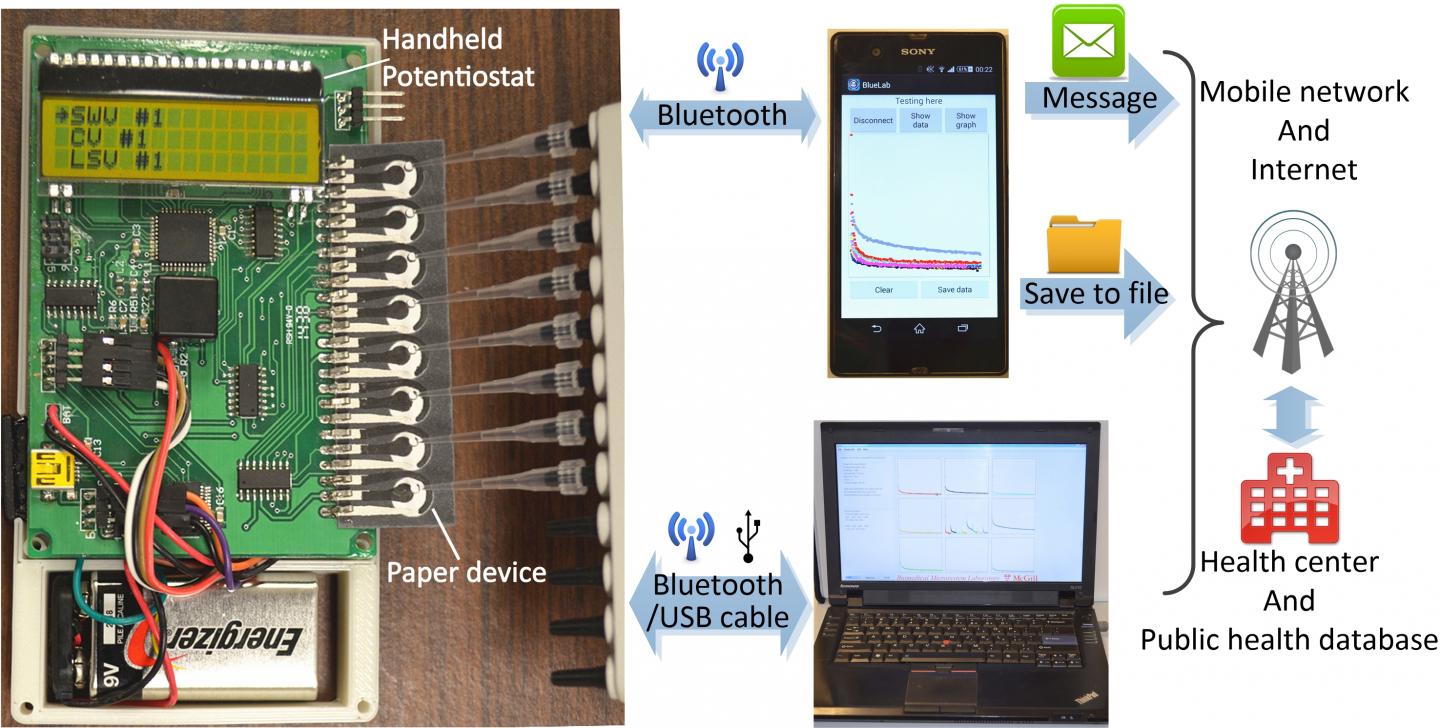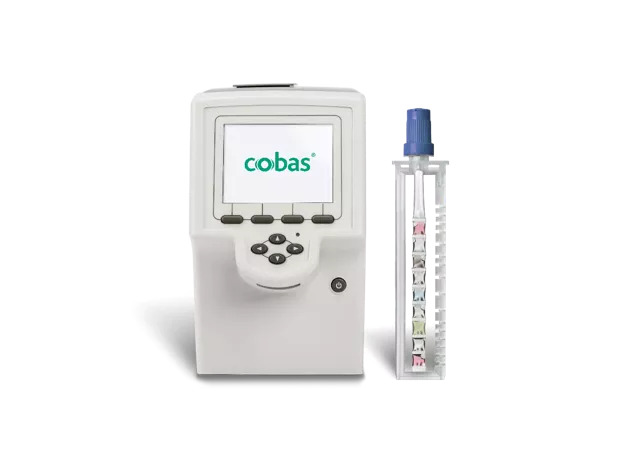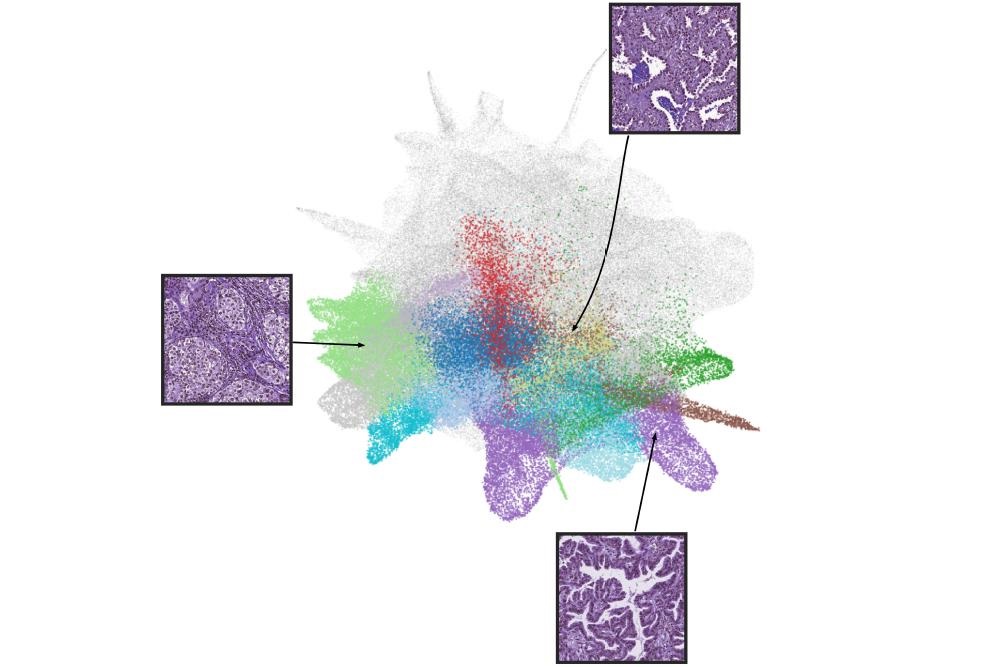On-the-Go Microfluidics Device May Provide Better Diagnostics of HIV/HCV
|
By LabMedica International staff writers Posted on 21 Apr 2016 |

Image: A depiction of the novel diagnostic platform that may soon enable low-cost, POC diagnosis of HIV & HCV co-infections within serum samples: a portable, paper-based microfluidic platform with multiplexing and telemedicine capabilities (Photo courtesy of C. Zhao, McGill University).
Researchers have created the first paper-based electrochemical immunosensing platform for rapid, inexpensive, point-of-care (POC) diagnosis of human immunodeficiency virus (HIV) and Hepatitis C virus (HCV) co-infections with broader multiplexing range and higher sensitivity than currently available antibody tests.
An estimated one-third of people with HIV/AIDS are co-infected with HCV. While rapid POC tests are available, they tend not to be affordable or accurately quantify marker concentrations, which help determine stage of infection. The new portable platform, developed by researchers at McGill University (Montreal, QC, Canada) for diagnosing HIV/HCV co-infection within serum samples, includes an electrochemical microfluidic paper-based immunosensor array (E-μPIA) and has multiplexing ELISA and telemedicine capabilities.
"Our experimental setup consists of a paper device with 8 electrochemical biosensors—for handy, one-time, disposable use—and a custom-made, handheld electrochemical reader, or potentiostat, to keep costs as low as possible," explained Prof. Xinyu Liu, "It enables 8 [simultaneous tests]: 4 for HIV antibodies and 4 for HCV antibodies," which makes the test broader than existing HIV and HCV point-of-care tests.
When assessing sensitivity with spiked mouse serum samples, the device could detect HIV and HCV antibodies at 300 pg/mL and 750 pg/mL, respectively – values lower than available antibody tests.
To run a test, the paper device is simply inserted into a slot on the potentiostat, and microliter drops of serum sample and reagents are added to each biosensor. Pressing a button triggers the electrochemical measurements. The device is compatible with internet-based and mobile network-based e-health systems. Data from the 8 tests can be directly displayed on an LCD screen of the potentiostat or transmitted to a smartphone or personal computer and then to a remote site—a centralized laboratory or hospital—for diagnoses.
The researchers tested for potential cross-reaction between the HIV and HCV antibody tests and found no significant interference, demonstrating “that our diagnostic platform shows great potential for diagnosing HIV/HCV co-infections in real patient samples," said Prof. Liu.
The main advantage offered is the ability to run 8 tests for HIV and HCV in parallel within 20 minutes with high accuracy, sensitivity, and specificity. Beyond this, the "handheld multiplexing potentiostat makes the entire electrochemical platform portable and significantly improves its adaptability to POC applications," explained Prof. Liu. The next step is to continue fine-tuning for practical use: "We'll explore the stability of the paper device during long-term storage, and then begin real patient sample testing in Canada and Kenya," he added.
Given the wide applicability of electrochemical detection to many types of biomolecules, the platform "can be readily extended to the detection of other disease markers such as proteins, metabolites, ions, and nucleic acids," added Prof. Liu, "Our long-term goal is to further extend the functionality of this diagnostic platform."
The study presenting the device design and testing, by Zhao C and Liu X, was published April 12, 2016, in the American Institute of Physics’ journal Biomicrofluidics.
Related Links:
McGill University
An estimated one-third of people with HIV/AIDS are co-infected with HCV. While rapid POC tests are available, they tend not to be affordable or accurately quantify marker concentrations, which help determine stage of infection. The new portable platform, developed by researchers at McGill University (Montreal, QC, Canada) for diagnosing HIV/HCV co-infection within serum samples, includes an electrochemical microfluidic paper-based immunosensor array (E-μPIA) and has multiplexing ELISA and telemedicine capabilities.
"Our experimental setup consists of a paper device with 8 electrochemical biosensors—for handy, one-time, disposable use—and a custom-made, handheld electrochemical reader, or potentiostat, to keep costs as low as possible," explained Prof. Xinyu Liu, "It enables 8 [simultaneous tests]: 4 for HIV antibodies and 4 for HCV antibodies," which makes the test broader than existing HIV and HCV point-of-care tests.
When assessing sensitivity with spiked mouse serum samples, the device could detect HIV and HCV antibodies at 300 pg/mL and 750 pg/mL, respectively – values lower than available antibody tests.
To run a test, the paper device is simply inserted into a slot on the potentiostat, and microliter drops of serum sample and reagents are added to each biosensor. Pressing a button triggers the electrochemical measurements. The device is compatible with internet-based and mobile network-based e-health systems. Data from the 8 tests can be directly displayed on an LCD screen of the potentiostat or transmitted to a smartphone or personal computer and then to a remote site—a centralized laboratory or hospital—for diagnoses.
The researchers tested for potential cross-reaction between the HIV and HCV antibody tests and found no significant interference, demonstrating “that our diagnostic platform shows great potential for diagnosing HIV/HCV co-infections in real patient samples," said Prof. Liu.
The main advantage offered is the ability to run 8 tests for HIV and HCV in parallel within 20 minutes with high accuracy, sensitivity, and specificity. Beyond this, the "handheld multiplexing potentiostat makes the entire electrochemical platform portable and significantly improves its adaptability to POC applications," explained Prof. Liu. The next step is to continue fine-tuning for practical use: "We'll explore the stability of the paper device during long-term storage, and then begin real patient sample testing in Canada and Kenya," he added.
Given the wide applicability of electrochemical detection to many types of biomolecules, the platform "can be readily extended to the detection of other disease markers such as proteins, metabolites, ions, and nucleic acids," added Prof. Liu, "Our long-term goal is to further extend the functionality of this diagnostic platform."
The study presenting the device design and testing, by Zhao C and Liu X, was published April 12, 2016, in the American Institute of Physics’ journal Biomicrofluidics.
Related Links:
McGill University
Latest Technology News
- Microneedle Patch Detects Skin Cancer Early
- New Diagnostic System Achieves PCR Testing Accuracy
- DNA Biosensor Enables Early Diagnosis of Cervical Cancer
- Self-Heating Microfluidic Devices Can Detect Diseases in Tiny Blood or Fluid Samples
- Breakthrough in Diagnostic Technology Could Make On-The-Spot Testing Widely Accessible
- First of Its Kind Technology Detects Glucose in Human Saliva
- Electrochemical Device Identifies People at Higher Risk for Osteoporosis Using Single Blood Drop
- Novel Noninvasive Test Detects Malaria Infection without Blood Sample
- Portable Optofluidic Sensing Devices Could Simultaneously Perform Variety of Medical Tests
- Point-of-Care Software Solution Helps Manage Disparate POCT Scenarios across Patient Testing Locations
- Electronic Biosensor Detects Biomarkers in Whole Blood Samples without Addition of Reagents
- Breakthrough Test Detects Biological Markers Related to Wider Variety of Cancers
- Rapid POC Sensing Kit to Determine Gut Health from Blood Serum and Stool Samples
- Device Converts Smartphone into Fluorescence Microscope for Just USD 50
Channels
Clinical Chemistry
view channel
New ADLM Guidance Provides Expert Recommendations on Clinical Testing For Respiratory Viral Infections
Respiratory tract infections, predominantly caused by viral pathogens, are a common reason for healthcare visits. Accurate and swift diagnosis of these infections is essential for optimal patient management.... Read more
3D Printed Point-Of-Care Mass Spectrometer Outperforms State-Of-The-Art Models
Mass spectrometry is a precise technique for identifying the chemical components of a sample and has significant potential for monitoring chronic illness health states, such as measuring hormone levels... Read more.jpg)
POC Biomedical Test Spins Water Droplet Using Sound Waves for Cancer Detection
Exosomes, tiny cellular bioparticles carrying a specific set of proteins, lipids, and genetic materials, play a crucial role in cell communication and hold promise for non-invasive diagnostics.... Read more
Highly Reliable Cell-Based Assay Enables Accurate Diagnosis of Endocrine Diseases
The conventional methods for measuring free cortisol, the body's stress hormone, from blood or saliva are quite demanding and require sample processing. The most common method, therefore, involves collecting... Read moreMolecular Diagnostics
view channel
Four-In-One Molecular Test Detects and Differentiates Among Most Prevalent Respiratory Viruses in 20 Minutes
The U.S. Centers for Disease Control and Prevention (CDC) has reported that respiratory diseases in the United States reached high levels during the recent autumn and winter seasons, with SARS-CoV-2 leading... Read more.jpeg)
First-Line PSA Testing More Cost-Effective Than First-Line MRI for Prostate Cancer Screening
Current prostate cancer (PCa) screening protocols typically begin with prostate-specific antigen (PSA) testing, which, if elevated, may lead to further assessment using multiparametric magnetic resonance... Read more
Proteomics Platform Identifies Proteins in Blood to Give Cancer Warning 7 Years before Diagnosis
To improve cancer survival rates, it's crucial to understand the disease during its initial stages. Research involving data from thousands of cancer patients has uncovered exciting findings about how blood... Read moreHematology
view channel
Next Generation Instrument Screens for Hemoglobin Disorders in Newborns
Hemoglobinopathies, the most widespread inherited conditions globally, affect about 7% of the population as carriers, with 2.7% of newborns being born with these conditions. The spectrum of clinical manifestations... Read more
First 4-in-1 Nucleic Acid Test for Arbovirus Screening to Reduce Risk of Transfusion-Transmitted Infections
Arboviruses represent an emerging global health threat, exacerbated by climate change and increased international travel that is facilitating their spread across new regions. Chikungunya, dengue, West... Read more
POC Finger-Prick Blood Test Determines Risk of Neutropenic Sepsis in Patients Undergoing Chemotherapy
Neutropenia, a decrease in neutrophils (a type of white blood cell crucial for fighting infections), is a frequent side effect of certain cancer treatments. This condition elevates the risk of infections,... Read more
First Affordable and Rapid Test for Beta Thalassemia Demonstrates 99% Diagnostic Accuracy
Hemoglobin disorders rank as some of the most prevalent monogenic diseases globally. Among various hemoglobin disorders, beta thalassemia, a hereditary blood disorder, affects about 1.5% of the world's... Read moreImmunology
view channel.jpg)
AI Tool Predicts Cancer Patients’ Response to Immunotherapy
Immune checkpoint inhibitors are a form of immunotherapy drug that enables immune cells to target and destroy cancer cells. At present, the Food and Drug Administration has approved two predictive biomarkers... Read more
Molecular Profiling Improves Diagnosis for Children with High Risk Cancers
Cancer remains the leading cause of disease-related death among children in most developed nations, and approximately one-fourth of these patients are diagnosed with aggressive, high-risk, or relapsed... Read morePathology
view channel
New WHO Reporting System for Lung Cytopathology to Enhance Diagnostic Accuracy
Lung cancer continues to be the most common cause of cancer-related deaths worldwide and ranks as the second most frequently diagnosed cancer in both men and women. The role of lung cytopathology, which... Read more
Self-Taught AI Tool Diagnoses and Predicts Severity of Common Lung Cancer
A computer program powered by artificial intelligence (AI) and trained on nearly half a million tissue images can effectively diagnose cases of adenocarcinoma, the most prevalent type of lung cancer.... Read more
Novel AI-Powered Method for Tissue Analysis Improves Understanding of Disease Pathology
Scientists at Brown University (Providence, RI, USA) and the University of Michigan (Ann Arbor, MI, USA) have created a groundbreaking computational technique to examine complex tissue data, potentially... Read moreTechnology
view channel
Microneedle Patch Detects Skin Cancer Early
Wearable bioelectronics has emerged as a significant innovation in healthcare, especially in the field of biosensing, providing a new method to monitor individual health for both diagnostic and therapeutic purposes.... Read more
New Diagnostic System Achieves PCR Testing Accuracy
While PCR tests are the gold standard of accuracy for virology testing, they come with limitations such as complexity, the need for skilled lab operators, and longer result times. They also require complex... Read moreIndustry
view channel
Roche and Hitachi High-Tech Extend 46-Year Partnership for Breakthroughs in Diagnostic Testing
Roche (Basel, Switzerland) and Hitachi High-Tech (Tokyo, Japan) have renewed their collaboration agreement, committing to a further 10 years of partnership. This extension brings together their long-standing... Read more
Danaher and Johns Hopkins University Collaborate to Improve Neurological Diagnosis
Unlike severe traumatic brain injury (TBI), mild TBI often does not show clear correlations with abnormalities detected through head computed tomography (CT) scans. Consequently, there is a pressing need... Read more
Beckman Coulter and MeMed Expand Host Immune Response Diagnostics Partnership
Beckman Coulter Diagnostics (Brea, CA, USA) and MeMed BV (Haifa, Israel) have expanded their host immune response diagnostics partnership. Beckman Coulter is now an authorized distributor of the MeMed... Read more_1.jpg)












.jpg)


